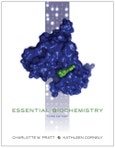Table of Contents
PART ONE FOUNDATIONS
1 THE CHEMICAL BASIS OF LIFE 1
1–1 What is Biochemistry? 2
1–2 Biological Molecules 3
1–3 Energy and Metabolism 10
1–4 The Origin and Evolution of Life 14
2 AQUEOUS CHEMISTRY 24
2–1 Water Molecules form Hydrogen Bonds 25
2–2 The Hydrophobic Effect 30
2–3 Acid Base Chemistry 33
2–4 Tools and Techniques: Buffers 41
PART TWO MOLECULAR STRUCTURE AND FUNCTION
3 FROM GENES TO PROTEINS 51
3–1 DNA Is the Genetic Material 52
3–2 Genes Encode Proteins 61
3–3 Genomics 65
3–4 Tools and Techniques: Manipulating DNA 70
4 PROTEIN STRUCTURE 87
4–1 Proteins Are Chains of Amino Acids 89
4–2 Secondary Structure: The Conformation of the Peptide Group 96
4–3 Tertiary Structure and Protein Stability 99
4–4 Quaternary Structure 107
4–5 Tools and Techniques: Analyzing Protein Structure 108
5 PROTEIN FUNCTION 121
5–1 Myoglobin and Hemoglobin: Oxygen–Binding Proteins 122
5–2 Structural Proteins 133
5–3 Motor Proteins 144
6 HOW ENZYMES WORK 158
6–1 What Is an Enzyme? 159
6–2 The Chemistry of Catalysis 162
6–3 The Unique Properties of Enzyme Catalysts 171
6–4 Some Additional Features of Enzymes 174
7 ENZYME KINETICS AND INHIBITION 188
7–1 Introduction to Enzyme Kinetics 189
7–2 Derivation and Meaning of the Michaelis Menten Equation 191
7–3 Enzyme Inhibition 200
8 LIPIDS AND MEMBRANES 220
8–1 Lipids 221
8–2 The Lipid Bilayer 227
8–3 Membrane Proteins 230
8–4 The Fluid Mosaic Model 233
9 MEMBRANE TRANSPORT 241
9–1 The Thermodynamics of Membrane Transport 242
9–2 Passive Transport 246
9–3 Active Transport 252
9–4 Membrane Fusion 255
10 SIGNALING 266
10–1 General Features of Signaling Pathways 267
10–2 G Protein Signaling Pathways 271
10–3 Receptor Tyrosine Kinases 277
10–4 Lipid Hormone Signaling 281
11 CARBOHYDRATES 290
11–1 Monosaccharides 291
11–2 Polysaccharides 294
11–3 Glycoproteins 299
PART THREE METABOLISM
12 METABOLISM AND BIOENERGETICS 308
12–1 Food and Fuel 309
12–2 Metabolic Pathways 314
12–3 Free Energy Changes in Metabolic Reactions 323
13 GLUCOSE METABOLISM 338
13–1 Glycolysis 339
13–2 Gluconeogenesis 354
13–3 Glycogen Synthesis and Degradation 357
13–4 The Pentose Phosphate Pathway 361
14 THE CITRIC ACID CYCLE 370
14–1 The Pyruvate Dehydrogenase Reaction 371
14–2 The Eight Reactions of the Citric Acid Cycle 374
14–3 Anabolic and Catabolic Functions of the Citric Acid Cycle 384
15 OXIDATIVE PHOSPHORYLATION 394
15–1 The Thermodynamics of Oxidation Reduction Reactions 395
15–2 Mitochondrial Electron Transport 399
15–3 Chemiosmosis 408
15–4 ATP Synthase 410
16 PHOTOSYNTHESIS 420
16–1 Chloroplasts and Solar Energy 422
16–2 The Light Reactions 425
16–3 Carbon Fixation 432
17 LIPID METABOLISM 442
17–1 Fatty Acid Oxidation 445
17–2 Fatty Acid Synthesis 453
17–3 Synthesis of Other Lipids 463
18 NITROGEN METABOLISM 475
18–1 Nitrogen Fixation and Assimilation 476
18–2 Amino Acid Biosynthesis 480
18–3 Nucleotide Biosynthesis 488
18–4 Amino Acid Catabolism 494
18–5 Nitrogen Disposal: The Urea Cycle 498
19 REGULATION OF MAMMALIAN FUEL METABOLISM 509
19–1 Integration of Fuel Metabolism 510
19–2 Hormonal Control of Fuel Metabolism 515
19–3 Disorders of Fuel Metabolism 520
PART FOUR GENETIC INFORMATION
20 DNA REPLICATION AND REPAIR 529
20–1 DNA Supercoiling 530
20–2 The DNA Replication Machinery 533
20–3 Telomeres 540
20–4 DNA Damage and Repair 543
20–5 DNA Packaging 552
21 TRANSCRIPTION AND RNA 561
21–1 Transcription Initiation 563
21–2 RNA Polymerase 571
21–3 RNA Processing 576
22 PROTEIN SYNTHESIS 590
22–1 tRNA Aminoacylation 592
22–2 Ribosome Structure 596
22–3 Translation 599
22–4 Post–translational Events 608
GLOSSARY 617
SOLUTIONS 629
ANSWERS TO PRACTICE PROBLEMS PP–1
ANSWERS TO CLINICAL CONNECTION
QUESTIONS CC–1
INDEX I–1
Authors
Charlott Pratt received her Ph.D. in biochemistry from Duke University. She did post–doctoral research at the University of North Carolina at Chapel Hill and has contributed to numerous primary research articles and reviews. She is presently in the Department of Chemistry at Seattle Pacific University. She is co–author with Donald Voet and Judith Voet of Fundamentals of Biochemistry, also published by Wiley.
Kathleen Cornely received her Ph.D. in biochemistry from Cornell University. She has published numerous research articles and is presently Professor in the Department of Chemistry and Biochemistry at Providence College. She is a member of the Educational and Professional Development Committee of the American Society for Biochemistry and Molecular Biology and is on the editorial borad for the journal, Biochemistry and Molecular Biology Education.








